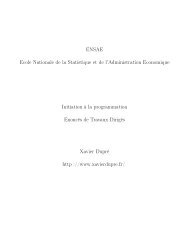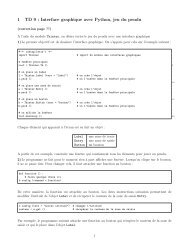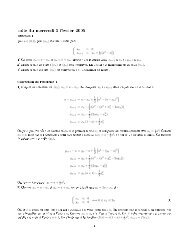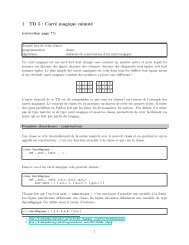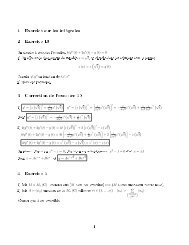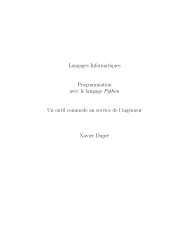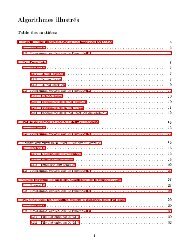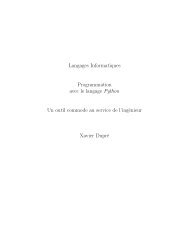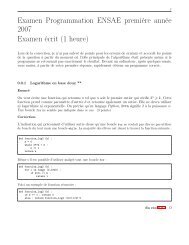Continuous line drawings via the traveling salesman ... - xavierdupre.fr
Continuous line drawings via the traveling salesman ... - xavierdupre.fr
Continuous line drawings via the traveling salesman ... - xavierdupre.fr
- No tags were found...
You also want an ePaper? Increase the reach of your titles
YUMPU automatically turns print PDFs into web optimized ePapers that Google loves.
Available on<strong>line</strong> at www.sciencedirect.comOperations Research Letters 32 (2004) 302 – 303OperationsResearchLetterswww.elsevier.com/locate/dsw<strong>Continuous</strong> <strong>line</strong> <strong>drawings</strong> <strong>via</strong> <strong>the</strong> <strong>traveling</strong> <strong>salesman</strong> problemRobert Bosch ∗ , Adrianne HermanDepartment of Ma<strong>the</strong>matics, Oberlin College, Oberlin, OH 44074, USAReceived 9 September 2003; received in revised form 19 September 2003; accepted 3 October 2003AbstractWe describe how to use <strong>the</strong> <strong>traveling</strong> <strong>salesman</strong> problem to create continuous <strong>line</strong> <strong>drawings</strong> of target pictures.c○ 2003 Elsevier B.V. All rights reserved.Keywords: Traveling <strong>salesman</strong> problem; <strong>Continuous</strong> <strong>line</strong> <strong>drawings</strong>; Art1. IntroductionIf you ever took a drawing class, even as a child,chances are good that at some point you made a continuous<strong>line</strong> drawing. (Art teachers are fond of <strong>the</strong>m.)When you did this, you looked at <strong>the</strong> object you wereasked to draw, you placed <strong>the</strong> tip of your drawing implementon your paper, and you made a <strong>line</strong> drawingof <strong>the</strong> object, taking great care to keep <strong>the</strong> tip of yourdrawing implement in contact with your paper untilyou were nished.When you were making your continuous <strong>line</strong>drawing, you were solving an optimization problem.Your objective was to produce <strong>the</strong> best possible<strong>line</strong> drawing of <strong>the</strong> object. What made this dicultwas <strong>the</strong> constraint: you were not allowed to removeyour drawing implement <strong>fr</strong>om <strong>the</strong> paper until yourdrawing was complete.In this brief note we describe how to construct <strong>traveling</strong><strong>salesman</strong> problem (TSP) instances that when∗ Corresponding author.E-mail addresses: bobb@cs.oberlin.edu (R. Bosch),aherman@cs.oberlin.edu (A. Herman).solved yield continuous <strong>line</strong> <strong>drawings</strong> of targetpictures.2. The procedureTo create a continuous <strong>line</strong> drawing of a targetpicture, we do <strong>the</strong> following:Step 1 (Format <strong>the</strong> target picture): Resize <strong>the</strong>target picture so that it is km × kn (i.e., so that ithas km rows and kn columns of pixels). Then convertit into PGM (portable graymap) format. In PGMformat, each pixel has a grayscale value between0 (completely black) and 255 (completelywhite).Step 2(Divide <strong>the</strong> target picture into squares):Partition <strong>the</strong> pixels of <strong>the</strong> target picture into m rowsand n columns of k × k squares. For each row i andcolumn j, compute <strong>the</strong> mean grayscale value ij of <strong>the</strong>pixels in square (i; j). Then set g ij = −⌊ ij =256⌋.Note that g ij is <strong>the</strong> average darkness of square (i; j)on a 0 (completely white) to (completely black)gray scale. For , we use an integer between 4 and 9,inclusive.0167-6377/$ - see <strong>fr</strong>ont matter c○ 2003 Elsevier B.V. All rights reserved.doi:10.1016/j.orl.2003.10.001
R. Bosch, A. Herman / Operations Research Letters 32 (2004) 302 – 303 303Fig. 1. Marilyn Monroe (20332 cities) and <strong>the</strong> Mona Lisa (27486 cities).Step 3(Construct andsolve <strong>the</strong> TSP instance):Divide <strong>the</strong> canvas into m rows and n columns ofsquares. For each row i and column j, randomly placeg ij cities (points) in square (i; j). Do this in such away that <strong>the</strong> cities in square (i; j) are uniformly distributedin square (i; j). After computing <strong>the</strong> intercitydistances, solve <strong>the</strong> TSP instance and plot <strong>the</strong> tour.Fig. 1 displays two continuous <strong>line</strong> <strong>drawings</strong> produced<strong>via</strong> this TSP-based procedure. One of our targetpictures was a 231 × 210 picture of Marilyn Monroe;<strong>the</strong> o<strong>the</strong>r was a 240 × 198 picture of a portion of<strong>the</strong> Mona Lisa. For both pictures, we used k = 3 and = 9. We used John Bradley’s XV package [2] toresize and format <strong>the</strong> target pictures and <strong>the</strong> chainedLin-Kernighan heuristic in Applegate, Bixby, Chvatal,and Cook’s Concorde [1] package to “solve” <strong>the</strong> TSPinstances.References[1] D. Applegate, R. Bixby, V. Chatal, W. Cook, Concorde—a code for solving Traveling Salesman Problems,http://www.princeton.edu/tsp/concorde.html.[2] J. Bradley, The On-Line Version of <strong>the</strong> XV 3.10a Manual,http://www.icgeb.trieste.it/∼netsrv/xvman/index.html.




